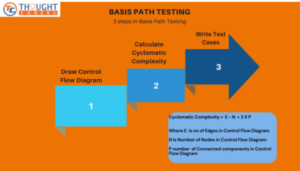Basis Path Testing emerges as a pivotal methodology within the realm of white-box testing, delving deep into the intricacies of a program or module’s control structure to ensure meticulous validation. By harnessing a comprehensive understanding of the program’s logic, this technique navigates through constructing a Control Flow Graph (CFG), providing a robust framework for systematic testing. Let’s delve into a detailed exploration of Basis Path Testing, elucidating its significance, procedures, and advantages.
Understanding the Need for Basis Path Testing:
In software development, the complexity of programs continues to escalate, necessitating rigorous testing methodologies to ensure reliability and functionality. Traditional testing approaches may overlook critical aspects of the program’s control flow, leading to undetected defects and vulnerabilities. Basis Path Testing addresses this challenge by offering a structured framework to comprehensively validate all possible execution paths within the program, minimizing the risk of overlooking critical scenarios.
Advantages of Basis Path Testing:
a. Comprehensive Coverage: Basis Path Testing ensures thorough exploration of the program’s control flow, validating every possible execution path. This comprehensive coverage minimizes the likelihood of undetected defects, enhancing software reliability.
b. Effective Defect Identification: By systematically traversing through the Control Flow Graph, Basis Path Testing facilitates the early detection and rectification of defects, reducing the cost and effort associated with debugging in later stages of development.
c. Enhanced Quality Assurance: With its systematic approach, Basis Path Testing elevates the overall quality assurance process by uncovering intricate control flow issues that might otherwise remain undetected. This contributes to delivering a robust and high-quality software product.
d. Optimized Testing Efforts: By focusing on independent paths within the program’s control flow, Basis Path Testing optimizes testing efforts, ensuring maximum coverage with minimal redundancy. This leads to efficient resource utilization and faster time-to-market.
e. Facilitates Maintenance and Refactoring: The structured nature of Basis Path Testing facilitates easier maintenance and refactoring of codebases. By providing insights into the program’s control structure, it aids developers in making informed decisions during code modifications and enhancements.
Key Steps in Basis Path Testing:
a. Constructing the Control Flow Graph (CFG): Develop visuals representation of the program’s control structure using a Control Flow Graph, highlighting nodes, edges, and special constructs such as junction nodes and decision nodes.
b. Computing Cyclometric Complexity: Evaluate the Cyclometric Complexity of the CFG to determine the number of independent paths within the program. This metric serves as a guideline for testing efforts. Enumerate and identify all feasible independent paths within the CFG, ensuring comprehensive coverage of the program’s control flow.

c. Designing Test Cases: Develop test cases tailored to traverse each independent path, encompassing diverse scenarios and inputs to validate the program’s functionality thoroughly.
Conclusion:
In conclusion, Basis Path Testing stands as an indispensable methodology in the arsenal of software testing techniques, offering a structured approach to validate the intricate control flow of programs. As software systems continue to evolve incomplexity, the significance of Basis Path Testing becomes
increasingly pronounced, serving as a cornerstone in ensuring software reliability and functionality.
Looking ahead, the future holds promising opportunities for further advancement and refinement of Basis Path Testing methodologies. With the advent of emerging technologies such as artificial intelligence and machine learning, there exists immense potential to integrate automated techniques into Basis Path Testing frameworks, streamlining the testing process and enhancing efficiency.
Moreover, as the software development landscape evolves, with trends such as microservices architecture and cloud-native applications gaining prominence, Basis Path Testing will continue to adapt and evolve to meet the evolving needs of the industry. Additionally, with the growing emphasis on security and compliance in software development, integrating security-focused testing practices into Basis Path Testing frameworks will be crucial to ensuring robust cybersecurity posture.
In essence, Basis Path Testing not only serves as a foundational pillar in software testing but also paves the way for continuous innovation and improvement in the field. By embracing evolving technologies and methodologies, practitioners can harness the full potential of Basis Path Testing to drive quality, reliability, and innovation in software development endeavors.



